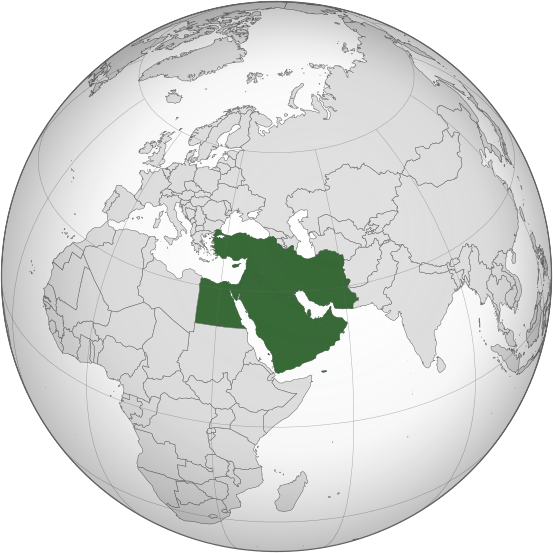Geen producten in je winkelmand.

- Dit event is voorbij.
Course on the Middle East
05/10/2018 @ 10:15 - 12:30
€248
Course on the Middle East
This course is about the history of what is called the ‘Middle East’ in spoken language. We will discuss the most relevant history for an understanding of the situation we are dealing with today. In this way the different religions in the area are discussed, the history of the great empires and their significance for the present and of course the origin of the modern nation states and development of the state of Israel. Ultimately, we also try to achieve a better understanding of the backgrounds of the news coverage of the same ‘Middle East’ in our contemporary media.
- Introduction – naming, meaning and geography.
In this lecture we start with a recent report from the media about the situation in the Middle East. We will define from there. What do you actually read? What is meant? What is suggested?
Ultimately, we try to develop a frame of reference with which we can explain historical developments in the Middle East. We build that frame of reference from relevant facts concerning the languages in the area, the peoples and national boundaries in the area, the religions in the area and the way in which the area is reported on in our contemporary media.
- Egypt and Judaism and the time before Christ
During this session we look at the many empires that succeed each other in this area since the third millennium Before Christ. We look at Ancient Egyptian civilization and at the Israelite kingdom.
We then see how a monotheistic religion emerges from all those civilizations, which in the Middle East becomes the leitmotif for all religious developments in subsequent history.
We look at how Alexander the Great conquers the area and incorporates it into his realm. This is how Hellenic culture becomes an influence in the Middle East.
In the 1st century Before Christ the region around the Mediterranean was conquered by the Roman Empire. As a result, this part of the Middle East was united with North Africa and a large part of Europe. So in this period, an internal connection between Europe and North Africa is developed.
- The first centuries after Christ
During this session we see how Persia becomes a major player in this area in the first centuries after Christ. In the same period Christianity spread through the Roman-occupied territories of the Middle East. In the fourth century, the Roman Empire got a new name there: the Byzantine Empire. The capital of that empire was Byzantium and later Constantinople, the current Istanbul. To the east of the Byzantine Empire, in Persia, the Partes and later the Sassanids emerged. Mesopotamia was a buffer between the Byzantine Empire and the Persian empires.
We look at the importance of the Council of Nicaea in 325 and see how as a result of that Council the monotheistic Christianity becomes a polytheistic Christianity.
We look at how and why this Christianity could spread through the area of the Roman Empire.
- The emergence of Islam
During this lecture we see how Islam is invisible in this area before the year 600, while after 800 Islam is clearly present. At the same time, minorities of older cultures and religions have always lived in this area, such as Zoroasters, Yezidis, and for instance Christian Copts and Maronites. We look at the rise of Islam in the Middle East and see how in the eyes of Europe, the area now has its own culture, its own religion and its own identity, which, compared to Europe and Africa of the 21st century, it generally still has. Often the enormous fragmentation within that cultural space falls outside the field of view of the Western spectator. The world of Islam in our contemporary western media always seems like a mass of formless barbarians, while nothing could be less true.
To clarify this we will discuss the schism that led to the subdivision within Islam, which consists of Sunnism and Shiism. In the east, Persia quickly became more or less independent and predominantly Shiite.
- The Crusades
During this session we see how the Christian Byzantine Empire was defeated by the Seljuqs in the Battle of Manzikert in 1071. Then the Byzantine emperor Alexios I Komnenos sent a request for help to Pope Urban II. This pope then organized the first crusade in 1095 and an army of crusaders conquered Jerusalem in 1099. After this they founded the Kingdom of Jerusalem, as well as three other states. The empires of the Abbasids, Seljuqs and Fatimids reacted somewhat indifferently as they were hardly interested in the conquered area.
In 1187 the Kurdish leader Saladin captured Jerusalem on the crusaders. After this, several crusades were organized, but none of them had a major influence on the Middle East.
We ask the question who or what the crusaders were actually fighting. In any case, they can not have been Muslims. Or were they?
- The Mongols
During this session we will discuss the destructive role that the Mongols have played in the Middle East.
Mongolian leader Genghis Khan invaded the Middle East in 1219. His troops destroyed in 1221 one of the two bases of civilization in the area – the old city of Merv. Perhaps more than a million people died in this conquest, which would make it one of the largest massacres in world history. In 1243 the Seljuqs were made vassals and the Mongols destroyed the capital Baghdad – the second base of civilization in this area – and in 1258 the empire of the Abbassids was destroyed. Between 1258 and 1260 the Mamelukes were expelled from Syria. The Mongols remained the greatest power in the Middle East until 1405. In that year their last great leader Timur Lenk died. To this day he is considered Turkish as well as Mongolian.
- The Ottoman Empire
During this lecture we see how around 1330 Osman I came to power in Anatolia. He founded the Ottoman Empire (named after him), which initially occupied the Balkans and parts of Eastern Europe and from 1516 on conquered the Mameluke area in Anatolia and in what is now Syria, Palestine and Egypt. In 1517 the Sharif – the religious ‘protector’ – of Mecca recognized the Sultan as caliph, so to say as religious leader. Thus he became both political and religious leader. In 1534 the Ottoman Empire conquered Baghdad and in 1546 Basra fell. Bahrain and parts of Oman and Yemen also submitted to the Ottomans. Until the First World War the Ottoman Empire held its grip on the Middle East.
We also look at how during the forceful implementation of nationalism during the nineteenth century, the Jewish community in Europe strives to establish a Jewish state. At the end of that century, political Zionism emerged, which aimed at establishing a Jewish state explicitly in the Middle East.
- The First World War and the Balfour Declaration
In this session we will discuss how during the First World War, the Ottoman Empire was defeated and the political situation in the Middle East changed drastically. During this war the territory of most of the states in the present Middle East was determined. The French and the British agreed on a distribution of the Middle East in their Sykes-Picot Treaty of 1916. In addition, the British promised authority over the Arab part in this area to the Arabs. That turned out to be an empty promise, because after the war the League of Nations, in line with British-French agreements, decided that the new countries Iraq, Palestine Cisjordania (what is called ‘Palestine’ today and includes the state of Israel) and Palestine Transjordania (which is called ‘Jordan’) would become a British mandate. Syria and Lebanon would become a French mandate. The British gave Iraq and Palestine Transjordan limited autonomy, the other areas remained under stricter control.
In 1917 the British proclaimed their Balfour declaration, which promised the Jews the formation of a ‘Jewish National Home’ in Palestine. Even before the establishment of the state of Israel, Zionism was a source of tension in what was then Palestine. The Zionist territorial claim has always been disputed and fought by the Arab population of Palestine and later by the Arab countries and thus also by the Palestinians.
- The Second World War and the declaration of the state of Israel
The Second World War has had few direct consequences for the Middle East. Only Iran, which had chosen the side of Germany, was invaded by the Allies. The Nazis invaded North Africa and their famous general Erwin Rommel reached Egypt in 1942, but the British defeated him at El Alamein, west of the Nile. In March 1943 the Axis Powers were expelled from North Africa.
The indirect consequences of the war were all the more greater in the Middle East. In 1943 the French mandate over Lebanon was ended and Lebanon became an independent republic. Within a few years after the war, the other mandates were also ended and more countries became independent.
After the British mandate for Palestine had expired, the state of Israel was declared in 1948. The neighboring Arab countries, whose populations had been against the influx of Jews for decades, promptly declared war on the new state, which lead to the First Arab-Israeli war. Of course we will discuss the significance of these important developments in depth.
- The Cold War and the period between 1991 and now
During this last session we look at the role that the Cold War has played in the Middle East. We see how in 1956 the French and British tried to regain control of the Suez Canal, which had been nationalized by Egyptian President Nasser. They made a secret agreement with Israel, which wanted to control Sinai itself in order to resist Egyptian attacks, with which the Suez crisis of 1956 began.
The United States did, afraid their allies might ruin American pro-Arab efforts, not support the attack, and exercised its influence in the area. At an earlier stage the Soviet Union also intervened in the politics of the Middle East in search of influence. The Soviets supported several countries in their Arab-nationalist aspirations, that had a strong socialist component, popular at that moment in time – to which the United States reacted again. The Cold War in the Middle East had started.
During this last lecture we will discuss the significance of the wars that Israel has waged for the current situation in the Middle East. We see how after 11 September 2001 our idea about the Islamic world has completely changed.
Finally, we try to come to a conclusion about the current situation in the Middle East and the way in which this situation is reported in contemporary media.
This course consists of ten lectures, that are given on Fridays from 10:15 in the morning until 12:30 in the afternoon at the Dominicus Kerk at Spuistraat 12. The course starts on Friday October 5th, 2018 and ends on Friday December 15th, 2018. Due to the October holiday there will be no lecture on Friday October 26th.
With this lecture series you will receive a free digital syllabus.
